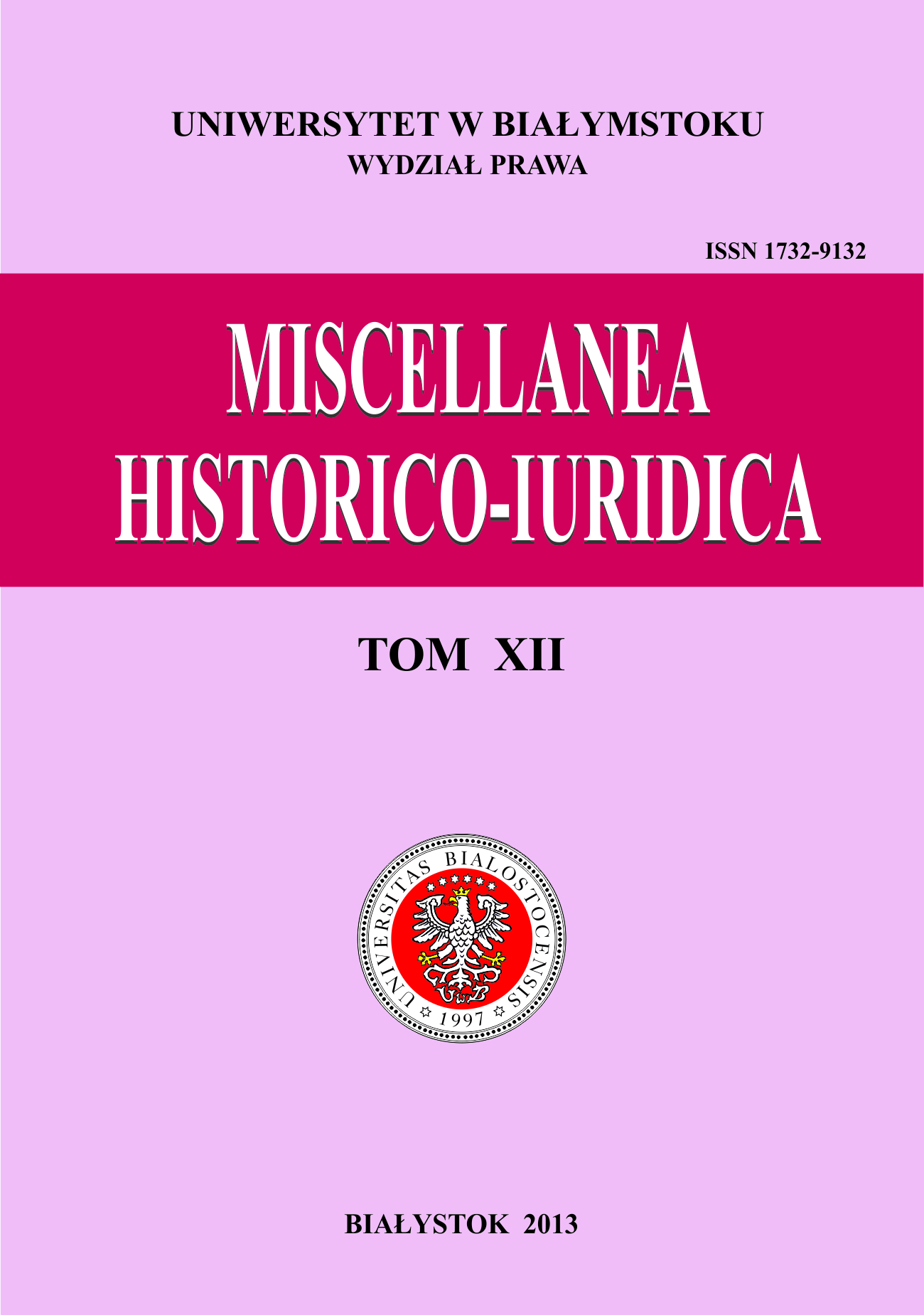Augustus nova officia excogitavit (Suet., Aug. 37). Oktawian August twórcą cura urbis?
Słowa kluczowe:
Augustus, Suetonius, Roman public law, cura urbis, curatores urbiAbstrakt
The curatores urbi, together with the prefects, are a part of the most characteristic Roman offices during the period of the principate. Thanks to the available source texts, particulary De aquaeductu urbis Romae, as well as thanks to the inscriptions, nowadays we have fairly precise information about the functions fulfilled by those officials. The doubts concern primarily the moment and the circumstances of the creation of the curatores urbi. According to Suetonius those officials, and especially curatores aquarum, curatores riparum et alvei Tiberis, curators aedium sacrarum et operum locorumque publicorum and curatores viarum were created by Augustus. However, that opinion raises doubts. The purpose of this very article is to determine to what extent the opinion of Suetonius is true and correct.
Bibliografia
Aldrete G.S., Floods of the Tiber in ancient Rome, Baltimore 2007.
Broughton T.R.S., The Magistrates of the Roman Republic, vol. II, 99 B.C.–31 B.C., New York 1952.
Bruun Ch., Die ‘Historia Augusta’, die Proskriptionen des Severus und die ‘curatores operum publicorum’, „Arctos” 1990, nr 24.
Burdese A., Manuale di diritto pubblico romano, Torino 1987.
Cosenza M.E., Official Positions after the Time of Constantine, Pennsylvania 1905.
de la Peña Olivas J.M., Alcance y organización de las obras públicas en el Imperio Romano, [w:] Nuevos de las obras Públicas Romanas, Astorga 2006.
Eck W., ‘Cura viarum’ und ‘cura aquarum publicorum’ als kollegiale Ämter im frühenprinzipat, „KLIO” 1992, nr 74.
Fischer R., Umweltschützende Bestimmungen im römischen Recht, Aachen 1996.
Girard P.F., Textes de droit romain. Publié et annoté, Paris 1913.
Impallomeni G., L’editto degli edili curuli, Padova 1955.
Kamińska R., Ochrona dróg publicznych przez urzędników rzymskich, „Zeszyty Prawnicze” 2008, nr 8.2.
Kamińska R., ‘Cura aquarum’ w prawie rzymskim, „Zeszyty Prawnicze” 2010, nr 10.2.
Kamińska R., Zarys kompetencji edylów jako urzędników miejskich, „Studia Prawno-Ekonomiczne” 2013, nr 88.
Kamińska R., Organizacja ‘cura urbis’ w Rzymie w początkach pryncypatu, „Zeszyty Prawnicze” 2013, nr 13.1.
Kolb A., Die kaiserliche Bauverwaltung in der Stadt Rom, Stuttgart 1993.
Kunkel W., Wittmann R., Staatsordnung und Staatspraxis der römischen Republik, München 1995.
Kuryłowicz M., ‘Tresviri capitales’ oraz edylowie rzymscy jako magistratury policyjne, „Annales UMCS”, Sec. G Ius, 1993, nr 40.
Kuryłowicz M., Nadzór magistratur rzymskich nad porządkiem publicznym, [w:] Bezpieczeństwo i porządek publiczny – historia, teoria, praktyka: Konferencja naukowa. Hadle Szklarskie, 26 września 2003 r., red. E. Ura, Rzeszów 2003.
Kuryłowicz M., D. 48,24: ‘De cadaveribus punitorum’. Prawo rzymskie o zwłokach osób skazanych za przestępstwa przeciwko państwu, [w:] Salus rei publicae supremalex. Ochrona interesów państwa w prawie karnym starożytnej Grecji i Rzymu, red. A. Dębiński, H. Kowalski, M. Kuryłowicz, Lublin 2007.
Kuryłowicz M., Publiczne porządki i nieporządki pogrzebowe w okresie wczesnego cesarstwa rzymskiego, [w:] Ochrona bezpieczeństwa i porządku publicznego w prawie rzymskim, red. K. Amielańczyk, A. Dębiński, D. Słapek, Lublin 2010.
Le dictionnaire des antiquités, s.v.curatores aedium sacrarum, locorum et operum publicorum, red. M.M. Daremberg, Edm. Saglio, t. 1, vol. 2.
Lenel O., Das Edictum perpetuum, Leipzig 1927.
Mommsen Th., Römisches Staatsrecht 3, II.2 (Tübingen 1899), przedruk Graz 1952.
O akweduktach miasta Rzymu. Frontinus, przeł. i wstęp C. Kunderewicz, „Prace Zakładu Archeologii Antycznej IHKM PAN” 1961, z. 19.
Orestano R., Il „problema delle persone giuridiche” in diritto romano, Torino 1968.
Palma A., Le ‘curae’ pubbliche. Studi sulle strutture amministrative romane, Napoli 1991.
Palmirski T., How the commentaries to ‘de his qui deiecerint vel effuderint’ and ‘ne quisin suggrunda’ edicts could be used on the ground of ‘edictum de feris’, „RIDA” 2006, nr 53.
Palmirski T., Odpowiedzialność za szkody wyrządzone przez zwierzęta według ‘edictum deferis’, „Czasopismo Prawno-Historyczne” 2007, nr 59.1.
Robbe U., La differenza sostanziale fra ‘res nullius’ e ‘res nullius inbonis’. La distinzione delle ‘res’ pseudo-marcianea, I, Milano 1979.
Robinson O.F., Ancient Rome. City Planning and Administration, London–New York 1992.
Rotondi G., ‘Leges Publicae Populi Romani’. Elenco cronologico con una introduzione sull’attività legislativa dei comizi romani, Milano 1912 (Hildesheim 1962, przedruk).
Ruciński S., ‘Praefectus Urbi’. Strażnik porządku publicznego w Rzymie w okresie wczesnego Cesarstwa, Poznań 2008.
Scherillo G., Lezioni di diritto romano. Le cose, Milano 1945.
Shipley F.W., Agrippa’s Building Activities in Rome, Washington 1933, reprint Eugene 2008.
Smith W., Dictionary of Greek and Roman Geography, 1854, http://www.perseus.tufts.edu/hopper/text?doc=Perseus:text:1999.04.0064:entry=superaequum-geo.
Staccioli R.A., The Roads of the Romans, Los Angeles 2003.
Tarwacka A., Prawne aspekty urzędu cenzora w starożytnym Rzymie, Warszawa 2012.
Trisciuoglio A. ,‘Sarta tecta, ultrotributa, opus publicum faciendum locare’. Sugli appalti relativi alle opere pubblichenell’et`a repubblicana e augustea, Napoli 1998.
Varela Gil C., El estatuto jurídico del empleado público en derecho romano, Madrid 2007.
Viganò R., Appunti sulla ‘cura riparum et alvei Tiberis’: gestione diretta o indiretta?, [w:] Studi in onore di Gaetano Scherillo, Milano 1966.
Wissowa G., s.v. aedilis, „RE” 1894, nr 1, kol. 454.







